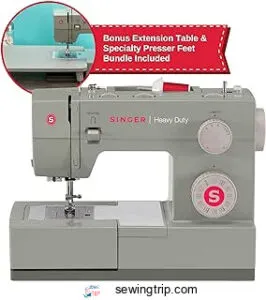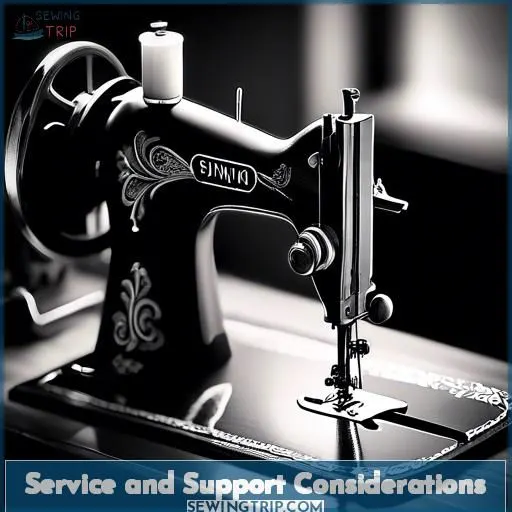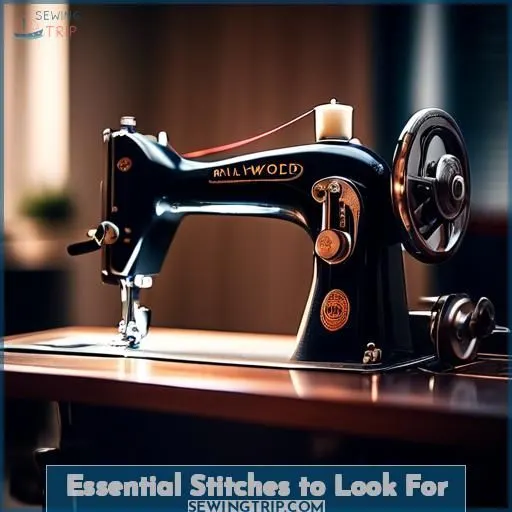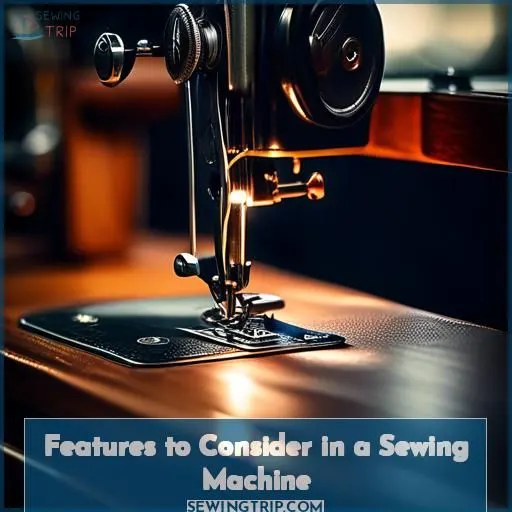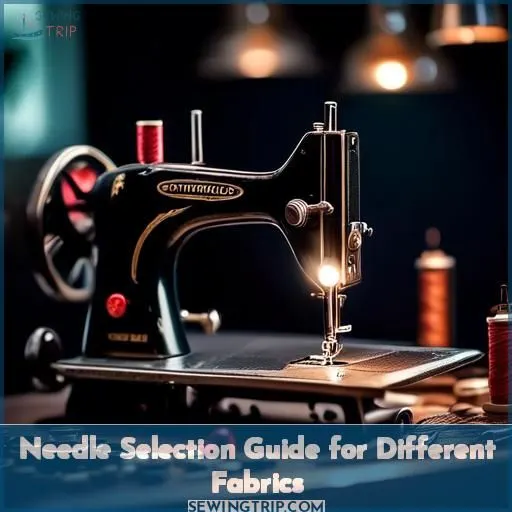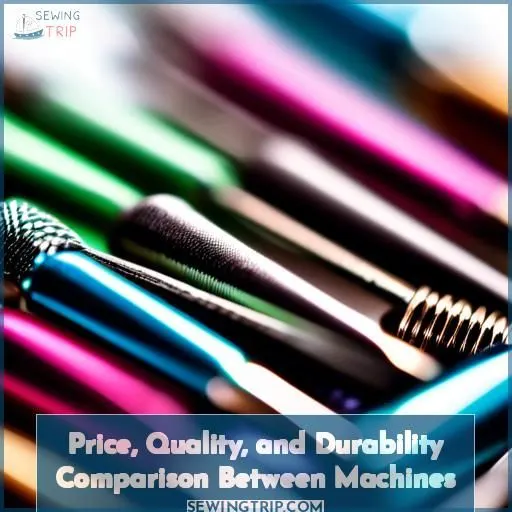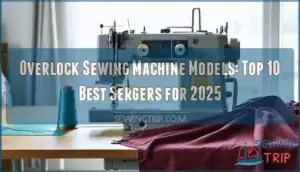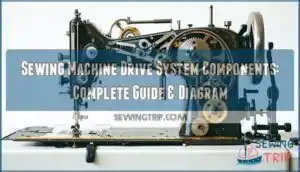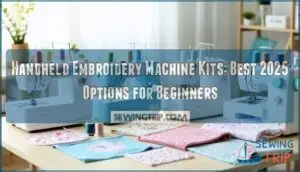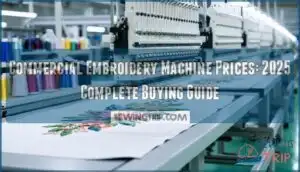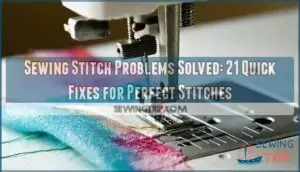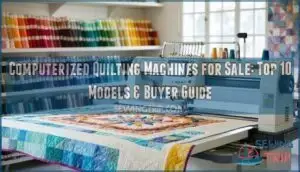This site is supported by our readers. We may earn a commission, at no cost to you, if you purchase through links.
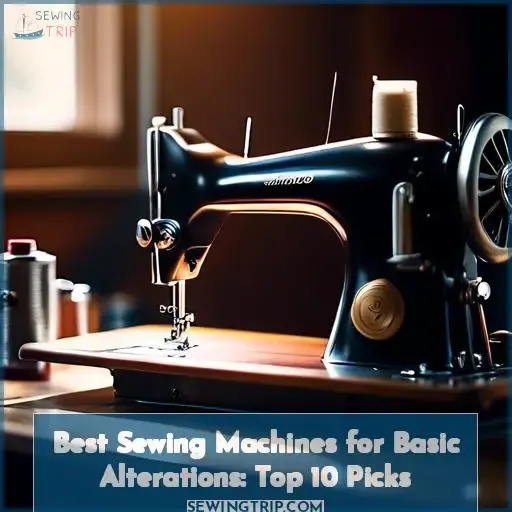 Imagine mastering the art of sewing like a pro!
Imagine mastering the art of sewing like a pro!
Our seamstress-approved guide unveils the best sewing machines for basic alterations in 2024.
From straight stitches to buttonholes, we’ve curated top-notch options tailored to your needs.
Elevate your skills with user-friendly features, durable construction, and expert insights.
Unleash your creativity and gain control over every project with precision.
Get ready to transform fabrics into personalized masterpieces effortlessly!
Table Of Contents
- Key Takeaways
- Top 10 Sewing Machines for Basic Alterations
- 1. Minri Mini Sewing Machine Kit
- 2. Brother 27 Stitch Sewing Machine
- 3. Portable Electric Sewing Machine
- 4. Juki HZL-K65 White Sewing Machine
- 5. SewingRite SewStation 101 Portable Sewing Table
- 6. Arrow Sewing Craft Chair Ruby Red
- 7. Singer Heavy Duty Sewing Machine Bundle
- 8. Janome HD3000 Sewing Machine
- 9. Juki Industrial Lockstitch DDL 8700
- 10. Bernette 35 Sewing Machine
- Service and Support Considerations
- Essential Stitches to Look For
- Features to Consider in a Sewing Machine
- Needle Selection Guide for Different Fabrics
- Price, Quality, and Durability Comparison Between Machines
- Frequently Asked Questions (FAQs)
- Conclusion
Key Takeaways
- The Singer 4423 Heavy Duty Sewing Machine is a top choice for beginners due to its sturdy construction, impressive warranty, and affordable price tag.
- Essential features for basic alterations include needle threaders, push-button start and stop, automatic thread cutters, speed adjusters, and additional sewing machine feet.
- Fabric-specific needle types, needle size selection, ball-point needle benefits, needle storage, and needle replacement are important considerations when selecting needles for a sewing machine.
- When comparing sewing machines, factors such as price, quality, durability, warranty length, and user reviews should be taken into account.
Top 10 Sewing Machines for Basic Alterations
Let’s dive into the top 10 sewing machines that are perfect for basic alterations, empowering you with the tools to keep your wardrobe looking its best. From beginner-friendly options to heavy-duty machines, we’ve got you covered for all your tailoring needs.
1. Minri Mini Sewing Machine Kit
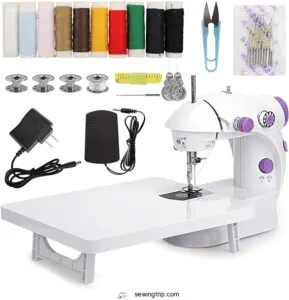
Dive into the world of sewing with the Minri Mini Sewing Machine Kit, your perfect ally for basic alterations. This little dynamo packs a punch with its large extension table, making your sewing projects smoother and more manageable.
It’s like having a mini sewing studio at your fingertips! Whether you’re fixing a hem or crafting a DIY masterpiece, this machine’s double threads and two speeds have got your back. Plus, it’s as portable as your ambition, ready to tag along on any creative adventure.
- Compact and lightweight, ideal for small spaces
- Comes with a comprehensive sewing kit, getting you started right out of the box
- Built-in lighting and thread cutter for added convenience
- Not suitable for heavy or thick materials
- Lacks a reverse function, limiting some sewing techniques
- May require some practice to master speed control
2. Brother 27 Stitch Sewing Machine
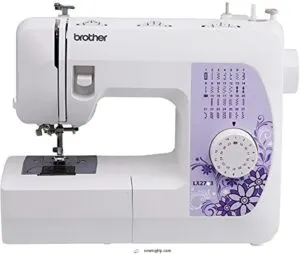
The Brother 27 Stitch Sewing Machine is a versatile and user-friendly option for both beginners and advanced sewers. With 27 built-in stitches and 63 stitch functions, this machine offers a wide range of options for various projects.
- Lightweight and portable design
- Brightly lit LED work area
- Automatic needle threading system
- Jam-resistant Quick-Set top drop-in bobbin
- Automatic bobbin winding system
- Includes 6 quick-change sewing presser feet
- Built-in easy needle threader
- Some users have reported issues with the machine’s tension control
- The machine may not hold tension for very long
Additional Information:
The Brother 27 Stitch Sewing Machine is designed for ease of use and comes with a variety of accessories, including 6 sewing feet, a 3-piece needle set, a twin needle, 4 bobbins, an instructional DVD, and a manual. The machine also offers a 25-year limited warranty and online technical support for the life of the machine.
3. Portable Electric Sewing Machine
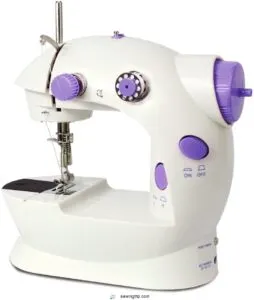
A portable electric sewing machine is a perfect choice for those who need a machine that’s easy to carry and store. These machines are lightweight and compact, making them ideal for travel or for those with limited space.
- Lightweight and portable
- Easy to store
- Suitable for basic sewing projects
- Affordable
- Limited stitch options
- May not be suitable for heavy-duty projects
- Not as durable as larger machines
When selecting a portable electric sewing machine, consider the following factors:
- Stitch variety: Look for machines with a range of built-in stitches to expand your creativity.
- Ease of use: Choose a machine that’s user-friendly, especially for beginners.
- Weight and portability: Consider the weight and portability of the machine for ease of transportation and storage.
- User reviews: Read reviews from other users to gauge performance and reliability before making a purchase.
Some popular portable electric sewing machines include the Mini Portable Electric Portable Household Overlock 12 Built-in Stitches with Foot Pedal for Amateurs Beginners, which is lightweight and easy to use.
Another option is the Portable Sewing Machine for Beginners Mini Electric Sewing Machine for DIY Home Travel, which is suitable for lightweight fabrics and comes with a foot pedal.
4. Juki HZL-K65 White Sewing Machine
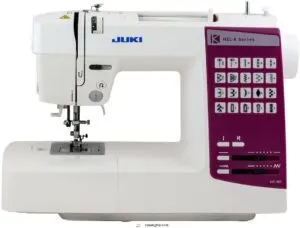
The Juki HZL-K65 White Sewing Machine is a highly recommended choice for basic alterations, boasting a range of user-friendly features and excellent performance.
- 20 stitch patterns to expand your creative possibilities
- Automatic needle threading for quick and easy setup
- Sensor buttonholes for perfectly sized buttonholes
- 15 needle positions for precise stitch placement
- Drop-in bobbin system for easy threading
- Free arm for sewing sleeves and cuffs
- Adjustable stitch length and width for customized effects
- Lock stitching options for decorative and secure seams
- LED light for better material handling
- Some users may find the automatic thread trimming to be too short
- Speed adjusters may hinder adaptation to industrial machines
- The machine may seem expensive for the features it offers
- Some users have reported initial tension issues
- The machine can be a bit noisy when turned on, which may indicate damage
Overall, the Juki HZL-K65 White Sewing Machine is a reliable and versatile choice for basic alterations, offering a range of features designed to enhance your sewing experience.
5. SewingRite SewStation 101 Portable Sewing Table
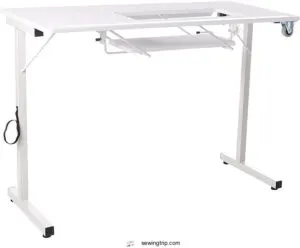
The SewingRite SewStation 101 Portable Sewing Table is a versatile and sturdy addition to your sewing space. With a laminate tabletop that won’t scratch or leave cut marks, this table provides 5.5 square feet of surface space, allowing you to comfortably work on larger projects.
The steel legs offer a stable work surface that can hold up to 50 pounds, making it suitable for a variety of sewing machines.
One of the key features of the SewStation 101 is its portability. It folds for easy storage and has wheels for easy transport, making it a great option for those with limited floor space or who need to move their sewing setup frequently.
The table also has a ruler on the front and an adjustable lever for the center table, providing added convenience.
The SewStation 101 is compatible with a Singer 201-2 sewing machine and can be customized for the height of your sewing machine support. The surface is flat with the bed of the sewing machine, ensuring a smooth sewing experience.
The table is easy to unfold and wheel around, and users have praised its sturdiness and value for the price.
However, some users have noted that the table shakes a bit when sewing at very high speeds, and there’s no height adjustment. Additionally, the table may not be as sturdy as some industrial machines, and the center table adjustment lever could be more robust.
- Portable design with foldable feature and wheels for easy transport
- Sturdy steel legs provide a stable work surface
- Laminate tabletop won’t scratch or leave cut marks
- Adjustable lever for the center table and ruler on the front
- Compatible with a variety of sewing machines, including Singer 201-2
- No height adjustment for the center table
- Shakes a bit when sewing at very high speeds
- Center table adjustment lever could be more robust
6. Arrow Sewing Craft Chair Ruby Red
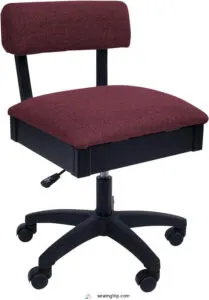
The Arrow Sewing Craft Chair Ruby Red is a fantastic addition to any sewing or crafting space. With its adjustable height from 18 to 22 inches, this chair allows for proper posture during long periods of sewing, ensuring comfort and reducing the risk of back pain.
The chair’s five-star 360° swivel base provides greater movement and stability, while the heavy-duty casters roll smoothly on most floors without marking.
- Adjustable height for proper posture
- Five-star 360° swivel base for greater movement and stability
- Heavy-duty casters roll smoothly on most floors without marking
- Hidden storage compartment under the seat for notions or patterns
- Durable upholstery fabric
- May not be suitable for individuals with limited space due to its size
- Some users may find the price to be on the higher side
- Assembly may require a standard screwdriver and easy-to-follow instructions
Overall, the Arrow Sewing Craft Chair Ruby Red is a well-designed and functional sewing chair that can enhance your sewing experience. Its combination of comfort, maneuverability, and storage makes it a worthwhile investment for any sewing enthusiast.
7. Singer Heavy Duty Sewing Machine Bundle
7. Singer Heavy Duty Sewing Machine Bundle
If you’re looking for a reliable and versatile sewing machine bundle that can handle basic alterations, the Singer Heavy Duty 4452 Sewing Machine Bundle is worth considering. This bundle includes the Singer Heavy Duty 4452 Sewing Machine, an extension table, and specialty presser feet to enhance your sewing experience.
- Powerful Motor: The heavy-duty motor provides more power for sewing multiple layers and thicker fabrics, making it suitable for a variety of projects.
- Easily Adjustable Presser Foot Pressure: The adjustable presser foot pressure allows you to customize your stitching experience, ensuring accurate results.
- Bonus Presser Feet: The bundle comes with a range of bonus presser feet, including a blind hem foot and an open toe foot, adding versatility to your sewing projects.
- Size and Weight: Due to its heavy-duty features, the Singer Heavy Duty 4452 Sewing Machine Bundle may be larger and heavier than some other sewing machines, which could impact portability.
- Price: While the bundle offers great value with its accessories, it may be priced higher than some other sewing machines on the market.
- User Experience: Some users have reported issues with the built-in needle threader, which may require manual threading in some cases.
Overall, the Singer Heavy Duty 4452 Sewing Machine Bundle is a solid choice for those seeking a reliable and versatile sewing machine for basic alterations. Its powerful motor, adjustable presser foot pressure, and bonus presser feet make it a valuable addition to any sewing enthusiast’s toolkit.
However, its size, weight, and potential need for manual threading may be drawbacks for some users.
8. Janome HD3000 Sewing Machine
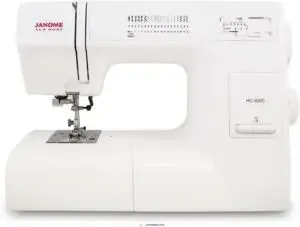
The Janome HD3000 is a mechanical sewing machine that’s perfect for basic alterations and home decor projects. With its heavy-duty construction and durable metal components, it’s built to last.
- Ease of Use: The Janome HD3000 is a simple machine to operate, making it ideal for beginners. It features a built-in needle threader, which eliminates the frustration of manual threading.
- Stitch Variety: This machine offers 18 stitches, including a one-step buttonhole, giving you plenty of options for your projects.
- Durability: The Janome HD3000 is designed to withstand the rigors of daily use, making it a reliable choice for your sewing needs.
- Easy to use with a built-in needle threader.
- Offers a variety of stitches for versatility.
- Durable and built to last.
- Not suitable for quilting or specialized techniques.
- Small harp space may limit the types of fabrics you can work with.
- No walking foot or free-motion capability.
9. Juki Industrial Lockstitch DDL 8700

Looking for a reliable and high-performance industrial lockstitch sewing machine? The Juki DDL-8700 might just be the one for you. With a maximum sewing speed of 5,500 stitches per minute, it’s perfect for handling medium-weight to light-weight fabrics.
The machine’s high-speed stitching performance is complemented by its extreme stitching performance, ease of operation, and reliability, which are all inherited from the highly evaluated previous Juki lockstitch machines.
The DDL-8700 is equipped with a 13mm presser foot lift, making it suitable for a range of fabrics. It also features a light-touch stitch dial and a throat plate with marker grooves for easy seam alignment.
The machine’s maintainability has been improved, with features such as an eccentric pin to adjust the feed dog and a mounting seat for attachment to improve workability.
- High-speed stitching performance
- Extreme stitching performance
- Ease of operation
- Reliability
- Improved maintainability
- May require professional assembly
- Missing manual for operation and putting together
- No light
- Not timed right
- Keeps breaking needles
The Juki DDL-8700 is a versatile industrial lockstitch sewing machine that can handle a variety of projects. If you’re looking for a machine that can handle straight lockstitching for light to medium-weight fabrics, this could be the one for you.
10. Bernette 35 Sewing Machine
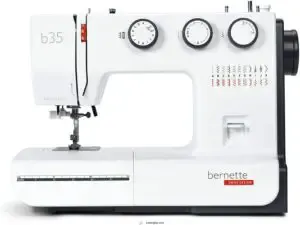
The Bernette 35 is a mechanical sewing machine designed for beginners, offering a range of 23 stitch patterns that are both basic and decorative. One of its standout features is the 1-step buttonhole function, which simplifies the process of creating buttonholes.
The machine also includes seven presser feet, allowing users to switch between different presser feet for various projects.
- 23 stitch patterns cater to a wide range of sewing projects.
- 1-step buttonhole function streamlines the buttonhole creation process.
- Seven presser feet provide versatility for different sewing applications.
- The Bernette 35 is a mechanical machine, which may not be as user-friendly for those who prefer computerized controls.
- The machine’s dimensions and weight may not be as compact as some other beginner sewing machines, making it less portable.
- The Bernette 35 doesn’t have an automatic needle threader, which may be a disadvantage for some users.
Service and Support Considerations
Make sure there are nearby repair shops, and research service options in both your current and future locations, especially if you move often.
Availability of Nearby Service and Repair Shops
Finding a trusty stitch wizard nearby can be a game-changer. Here’s why:
- Nearby Shops: Quick fixes beat waiting ages for online parts.
- Future Relocations: Moving? Scout out local talent for your machine’s spa days.
- Long-Distance Damage: A bumpy ride can jostle your machine’s guts. Local pros can straighten things out faster than you can say bobbin.
Research Service Options in Current and Future Locations
When shopping for a sewing machine, it’s crucial to consider the service and support options available in your current and future locations.
-
Availability of Nearby Service and Repair Shops: Look for local shops that offer sewing machine repair and maintenance services. This will ensure that you have easy access to professional assistance when needed.
-
Research Service Options in Current and Future Locations: Before making a purchase, research the service options available in your current location and any future locations where you might move. This will help you avoid potential inconvenience or frustration in the future.
-
Potential Damage During Long-distance Moves: If you plan to move in the future, consider the potential for damage during transportation. Dealer machines often come with added perks such as classes, tune-ups, and other services, which can be beneficial for long-distance moves.
To make an informed decision, consult the following table:
| Service Consideration | Details |
|---|---|
| Local Support | Ensure availability of nearby service and repair shops. |
| Warranty Coverage | Research service options in current and future locations. |
| Future Moves | Consider potential damage during long-distance moves. |
| Repair Options | Look for machines with easy-to-access parts and user-friendly repair mechanisms. |
| Dealer Perks | Opt for dealer machines for added services and support. |
Potential Damage During Long-distance Moves
Preparing for a long-distance move with your sewing machine can be daunting.
To protect your machine from shipping damage, consider purchasing transit protection or insurance options.
Warranty coverage may also extend to damages during transit.
Remember to remove any presser feet and store them separately.
Pack your machine in its original box or a sturdy container with padding.
If possible, use a removable extension table and storage tray to protect these accessories.
Essential Stitches to Look For
When choosing a sewing machine for basic alterations, you’ll want to make sure it offers the essential stitches.
Straight Stitch, Zig Zag, and Buttonhole Stitches
To ensure seamless alterations, focus on machines with a range of built-in stitch options.
Prioritize machines that offer stitch length, tension adjustment, and stitch width control.
Consider the fabric thickness and pattern selection capabilities.
Look for machines with built-in stitches for buttonholes, straight stitch, and zigzag, as well as seam finishes.
By choosing a machine with these features, you’ll be able to tackle a variety of sewing projects with ease.
Additional Zig Zag Options for Lingerie or Knits
When it comes to lingerie or knits, additional zig zag options can be a seamstress’s best friend. These stitches are designed to enhance the functionality of your sewing machine for delicate materials and ornamental details.
- Lingerie Stitches: Perfect for fine fabrics and undergarments, these stitches provide a smooth finish and ensure comfort.
- Knit Stitches: Ideal for stretch fabrics, these stitches adapt to the material’s flexibility, ensuring a flawless seam.
- Decorative Stitches: For those seeking more than just a functional stitch, these ornamental details add a touch of elegance to your projects.
Blind Hem Stitch for Costuming
After mastering zig zag stitches for your delicate lingerie and stretchy knits, let’s dive into the world of costuming with the blind hem stitch.
| Stitch Patterns | Embellishment Options |
|---|---|
| Blind Hem | Beads & Sequins |
| Topstitching | Appliqués |
| Basting | Embroidery |
| Gathering | Fabric Flowers |
| Smocking | Lace Trimming |
Features to Consider in a Sewing Machine
When choosing a sewing machine, consider features that enhance ease of use, such as needle threaders and push-button controls. Evaluate the efficiency of automatic thread cutters and speed adjusters, as they can impact your sewing experience and adaptation to industrial machines.
Needle Threaders and Their Ease of Use
Threading needles can be a frustrating task, especially for beginners. However, the right needle threader can make the process much easier.
- Thread Accessibility: Look for machines with easy-to-access thread guides and needle threaders. Some machines come with built-in threaders that automatically thread needles, making the process quicker and more convenient.
- Threading Ease: Manual threading is still essential knowledge, but machines with automatic threaders can be a lifesaver. These threaders often have a loop that catches the thread, preventing it from falling out while you’re sewing.
- Threading Steps: Some machines have a simple, step-by-step guide for threading, which can be helpful for beginners. This guide often includes illustrations or videos to walk you through the process.
- Needle Threader Types: There are various types of needle threaders, such as generic threaders, Clover threaders, LoRan threaders, and Dritz looped threaders. Each type has its own benefits and drawbacks, so it’s essential to choose the one that best suits your needs.
- Ease of Use: Needle threaders should be easy to use and not require excessive force or precision. Look for threaders that are sturdy and can handle different needle sizes without breaking.
By considering these features, you can find a sewing machine with a needle threader that’s easy to use and helps you avoid threading frustrations.
Push Button Start and Stop Necessity
Push button start and stop aren’t necessary features for all sewers.
But they can be convenient for those who prefer a more ergonomic design.
While these features may not be crucial for basic alterations, they can enhance the user experience.
When considering the best sewing machines for basic alterations, it’s essential to weigh the importance of these features against other factors.
Such as warranty coverage, built-in stitches, and ease of use.
Automatic Thread Cutters Efficiency
Automatic thread cutters can significantly improve the efficiency of your sewing process. They automatically cut the thread after each stitch, eliminating the need for manual thread cutting and reducing the risk of thread tangling.
This feature is especially useful when working with fine fabrics or when sewing multiple layers. However, the efficiency of automatic thread cutters can vary between machines, so it’s essential to consider this factor when choosing a sewing machine.
Some machines may have more efficient thread cutters than others, which can impact the overall performance and cost-effectiveness of the machine. Additionally, the side thread cutter, two-speed control, and stitch quality can influence the effectiveness of the automatic thread cutter.
It’s advisable to research and compare different machines to find the one that best suits your sewing needs and preferences.
Speed Adjusters Impact on Adaptation to Industrial Machines
Speed adjusters on your sewing machine are like training wheels for the Tour de France of fabric.
They smooth out the learning curve, especially when tackling bulky fabrics.
While manual threading might feel like a throwback, electronic machines with speed adjusters prep you for the big leagues of industrial machines.
Perfect for seamstresses aiming to master basic alterations without breaking a sweat.
Additional Sewing Machine Feet for Enhanced Functionality
As a seamstress, you know that the right sewing machine feet can make all the difference in your basic alterations.
To enhance functionality, consider investing in presser feet like attachments, hemmer feet, binder feet, ruffler feet, and seamstress feet.
These accessories are designed to make your sewing experience more efficient and precise, allowing you to tackle a variety of projects with ease.
By incorporating sewing machine feet into your toolkit, you’ll unlock the secrets to mastering basic alterations and elevating your sewing skills.
Needle Selection Guide for Different Fabrics
Let’s discuss which needles to use for different fabrics. Selecting the right needle size and type will ensure your stitches look their best and your projects turn out great.
Fabric-Specific Needle Types
When it comes to sewing, the choice of needle can significantly impact the quality of your work.
Different fabrics require specific needle sizes and materials for optimal results.
For instance, lighter fabrics like silk or satin may require smaller needles, while heavier fabrics like denim or canvas may need larger ones.
Additionally, understanding needle threading and storage is crucial for maintaining your sewing machine’s performance.
Replacing needles regularly is also essential, especially when working with thicker fabrics.
By considering these factors, you can enhance your sewing experience and achieve professional-quality alterations.
Needle Size Selection
When it comes to sewing projects, choosing the right needle size is crucial. Different fabrics require specific needle types for optimal performance.
- Needle Types: Understand the various needle types, such as universal, ball point, and sharp needles, and their applications.
- Needle Storage: Keep your needles organized and easily accessible in a needle case or storage box.
- Needle Replacement: Know when to replace your needles, as dull needles can cause damage to your fabric and sewing machine.
- Needle Disposal: Dispose of used needles safely to avoid injury or accidental punctures.
Ball Point Needle Benefits
Ball point needles are a must-have for sewing with knit and stretch knit fabrics. These needles are specifically designed to avoid breaking knit fibers at stitch creation, making them ideal for working with materials like lycra, spandex, and other stretchy fabrics.
They’ve a rounded end that pushes through the fibers in the fabric rather than piercing it, preventing snags or runs in the knit fabric.
When it comes to choosing the right needle size for your project, keep in mind that different fabrics require different needle sizes. For lighter knits, a size 70/10 or even 75/11 is a great choice. Size 80/12 will also work on most knits, while size 90/14 is best for sewing over bulky seams on thicker knit fabrics.
It’s essential to test the needle on a scrap of fabric first to ensure the fabric can handle the larger needle size.
Ball point needles are also beneficial when sewing webbing straps, especially if the webbing has some stretch or if it’s a delicate material prone to fraying. In these cases, a ball point needle can help prevent the fabric from getting damaged or puckering.
For those who are new to sewing with knits, it’s recommended to start with a ball point needle and then experiment with different needle sizes and types as you gain experience. Remember to always test your fabric and needles first to ensure the best results.
Price, Quality, and Durability Comparison Between Machines
After diving into the world of needles and their dance with different fabrics, let’s shimmy over to the nitty-gritty of sewing machine shopping.
You’re on a quest for a trusty steed that won’t buckle under the first sign of a denim fortress.
Price, quality, and durability are your trifecta of triumph.
Peek at the warranty length as a sneak peek into the manufacturer’s confidence.
A broad stitch range whispers versatility, while needle compatibility and presser feet availability shout adaptability.
Don’t just take the manufacturer’s word for it; user reviews are the secret sauce, offering unfiltered insights.
Your sewing machine isn’t just a purchase; it’s a partnership.
So, let’s make sure it’s one that lasts, without breaking the bank or your spirit.
Frequently Asked Questions (FAQs)
What are the best machines for basic alterations?
For basic alterations, go with a sturdy mechanical machine like the Singer 4411 Heavy Duty. Its metal interior, powerful motor, and top-loading bobbin make it a reliable workhorse you’ll love.
How do I choose the right sewing machine for my needs?
Determine your skill level and project goals. Beginner? Look for affordable, user-friendly machines. Advanced? Invest in heavy-duty, versatile models. Consider features like stitch variety, easy threading, and durability.
What features should I look for in a sewing machine for basic alterations?
Like a trusty sidekick, you need a simple, sturdy machine (idiom). Opt for straight, zigzag, and stretch stitches – the essentials. Forget bells and whistles (metaphor); focus on reliability for seams, hems, and minor repairs.
What are the best stitches for basic alterations?
For basic alterations, you’ll need a straight stitch for hems and seams, a zigzag for reinforcing edges, and maybe a stretch stitch for knits.
How do I maintain and care for my sewing machine for basic alterations?
Keep your machine lubricated, clean the bobbin area regularly, and invest in a sturdy cover. Use quality thread, needles, and bobbins – cheap ones can damage delicate parts. Be gentle when adjusting settings – forced changes can cause problems down the line.
Conclusion
Sewing a seamless future, the best sewing machine for basic alterations weaves functionality, precision, and user-friendly features into one remarkable package. Whether hemming pants or crafting custom outfits, you’ll stride confidently through every project with a top-notch machine by your side, transforming fabrics into wearable art pieces effortlessly.

